Federal contaminated sites: making progress
- Brevoort Island Remedial Options Analysis (PDF version - 4.2 MB)
- Colomac Mine Remediation Project (PDF version - 1.3 MB)
- Colwood Refuelling Facility Engineered Wetlands (PDF version - 2.0 MB)
- Wind-Powered Groundwater Sparging at Farnworth Lake (PDF version - 1.3 MB)
- Fort Nelson Airport Remediation Program (PDF version - 1.3 MB)
Brevoort Island remedial options analysis
An accidental fuel leak in harsh arctic conditions leads to an innovative approach to selecting the best remedial solution - while building "green" elements into the plan.
Background
A pipe failure at a Department of National Defence (DND) Long Range Radar Facility on Brevoort Island, located just off the coast of Baffin Island, Nunavut, led to the accidental release of about 150 000 litres of Jet A-1 aviation turbine fuel. After the release was discovered in 2007, DND carried out an environmental site assessment to determine the extent of the contamination.
Normally, the next step would be to carry out a standard remedial options analysis – essentially, looking at the engineering feasibility and financial considerations of the available ways to contain the release or decontaminate the site. Such an analysis was required by regulation, and to meet the requirements of stakeholders and an insurance claim associated with the assessment and remediation.
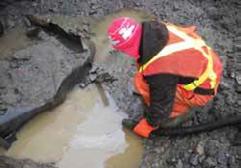
Photo: © Department of National Defence
Collecting contaminated water
The challenge
Several factors at Brevoort Island made conventional approaches impractical. The remoteness of the location would drive up the costs of transporting remediation equipment to the site and the removal of contaminated soil. Also, harsh arctic weather conditions, coupled with continuous permafrost, ruled out some remediation activities that could have had a negative effect on the delicate ecosystem. These factors limited the time available to carry out remediation activities.
The solution
Stantec Consulting, Ltd. was engaged to carry out a remedial options analysis that incorporated sustainability elements, including “green” remediation and reuse of waste materials. This analysis would then be used to evaluate and select the best possible solution to address the contamination at Brevoort Island.
The first step was to assess each contaminated medium, looking at:
- hydrocarbon-contaminated soil (both accessible and inaccessible to remediation efforts),
- groundwater contaminated by petroleum hydrocarbons (PHCs),
- booms and pads that had been used to adsorb PHCs, and
- aviation fuel recovered from the release.
Stantec then evaluated a range of remedial options, using a weighted scoring system. This system was based on the principles of multi-criteria decision analysis, which allowed for weighting of sustainability indicators, such as social and economic impacts, as part of an overall life cycle approach.
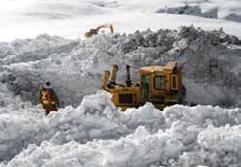
Photo: © Department of National Defence
Excavator removing contaminated snow
Stantec’s analysis took into account the factors considered in a conventional remedial options analysis - essentially, the scheduling, cost and feasibility of several engineering solutions. In the case of Brevoort Island, the following factors were also used to assess the available technologies:
- operations (regulatory approvals and degree of site disruption),
- reliability (maintenance requirements, vulnerability to downtime, and availability of parts),
- performance (monitoring requirements, option effectiveness, hydraulic control, infrastructure),
- logistical limitations (securing equipment and supplies for remedial operations), and
- track record.
The analysis also involved local stakeholder consultations and took into consideration a variety of environmental considerations:
- the human environment, including social factors (air quality, noise and vibration), health and safety,
- the natural environment, including soil and water quality, and
- sustainability indicators, such as reuse and recycling, and minimizing long-term disruption.
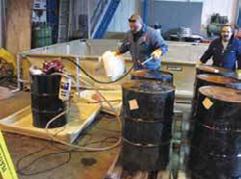
Photo: © Department of National Defence
Treatment and filtration of fuel
Outcomes and benefits
Once the remedial options analysis was complete, Stantec was able to provide DND with an option that had scored highest - and became part of an overall remedial action plan. The resulting treatment combined active remediation techniques with risk-assessment elements and a plan for the managed natural decreasing of the contaminants.
The chosen approach required minimal specialized expertise, which allowed for local employees to be included in the project team; it also made possible the collection of nearly 30 000 litres of fuel, which were then treated, filtered and reused in the site generators. Normally, collected fuel cannot be reused.
Perhaps just as important as the “green” aspects of this plan was the multi-criteria decision analysis. The analysis demonstrated to DND, stakeholders and affected communities that the chosen approach was the best possible solution overall - once human and environmental considerations were taken into account - and one that could be applied to similar situations in the future.
This project was made possible with support from the Federal Contaminated Sites Action Plan (FCSAP), a program aimed at reducing the environmental and human health risk, and associated federal financial liabilities, from known federal contaminated sites. More information about FCSAP is available at www.federalcontaminatedsites.gc.ca.
Public Services and Procurement Canada is mandated by FCSAP to promote the use of innovative technologies, approaches and best practices in the remediation of federal contaminated sites. This is one of a series of profiles featuring innovative, sustainable and green remediation technologies, approaches, and best practices in Canada.
Colomac Mine remediation project
Use of locally harvested materials, soil bioengineering techniques and natural processes lead to sustainable revegetation of river and lake shorelines after contamination by a closed gold mine
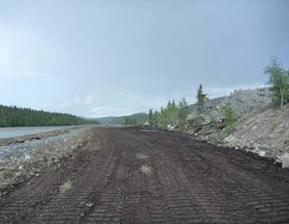
Photo: © Indigenous and Northern Affairs Canada
2010 - Steeves Lake shoreline infill and cap
Background
Closed in 1997, the Colomac gold mine, located 220 km north of Yellowknife, Northwest Territories, left behind contaminated sediments and harmful hydrocarbons that were leaching into nearby Steeves Lake. After the closure, Indigenous and Northern Affairs Canada (INAC) took on responsibility for the mine and the remediation of the area. In 2010, INAC hired a contractor, Tlicho Engineering & Environmental Services/Aboriginal Engineering Ltd. (TEES-AEL), to contain and cap the contaminants along a 750-metre stretch of shoreline, preventing them from reaching the lake.
The vegetation in the area - already a delicate ecosystem because of the harsh northern climate - had also been greatly disturbed by the mine’s operations and the remediation activity. An authorization under the Fisheries Act required the restoration of shoreline vegetation and riparian areas on the mine site: revegetation would undo some of the damage caused by the capping of Steeves Lake shoreline and other areas disturbed by historical mining activity, while root systems would reduce further erosion of the soil.

Photo: © Indigenous and Northern Affairs Canada
Revegetation materials collected and prepared on site
The challenge
Revegetation approaches usually involve first preparing sites by compacting the soil, then using commercial mixes of seeds to establish an initial plant cover, and occasionally transplanting seedlings or shrubs from nurseries. Often, little or no monitoring of success is performed afterward.
Yet several factors at the Colomac site would make revegetation especially challenging: the remote location would drive up costs for both labour and transporting materials; and the establishment of a heavily seeded initial cover in a subarctic climate could easily out-compete native species and hinder natural succession of vegetation at the site.
The need for a more holistic approach to revegetation was clear. INAC contracted Polster Environmental Services Ltd., which had expertise in land and riparian restoration, to assist in exploring options for revegetation at the Colomac site.
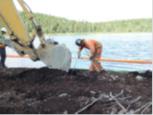
Photo: © Indigenous and Northern Affairs Canada
Live gravel-bar willow staking
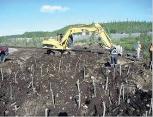
Photo: © Indigenous and Northern Affairs Canada
"Rough and loose" technique
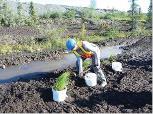
Photo: © Indigenous and Northern Affairs Canada
Wetland sedge transplant
The solution
Polster had already determined that, where the natural solutions to addressing problems in vegetation establishment are slow, there may be opportunities to accelerate the process by providing suitable plants or structures. Polster developed a plan that focused on the establishment of local species at the first stage of revegetation, using willow, alder and wetland sedges harvested from the mine site:
- A "rough and loose" technique to prepare the ground surface would create tiny sites for the seeds to lodge and germinate in, and improve natural recovery of the land.
- Using live willow cuttings as stakes would lead to quicker stabilization of the prepared ground and gravel bars.
- Using an arctic-grass seed mix and locally collected alder seeds in some areas would promote the establishment of natural vegetation.
- Sedge plugs would create new wetland and flood-zone areas.
As much as possible, the materials would be harvested from the mine site itself, reducing the need for transportation, lowering costs and using species that had already proven their ability to withstand the local climate.
The revegetation plan applied the same principle to using local skills and knowledge. TEES-AEL, the contractor that had done the original containment and capping, brought in the expertise of Flat River Consulting Ltd. to develop and oversee the revegetation treatments; Polster provided local training and capacity-building.
To ensure that the revegetation was not only completed, but also sustainable, Flat River established a monitoring framework for INAC, which includes annual and long-term monitoring, as well as photo documentation and sampling of vegetation plots to assess species composition and sustainability over time. In addition to documenting the recovery process, this monitoring also determines the overall success of the revegetation effort - and how the techniques might be applied at other sites.
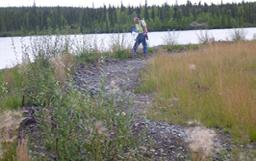
Photo: © Indigenous and Northern Affairs Canada
2012 - Steeves Lake shoreline cap and infill
Outcomes and benefits
Now that the revegetation plan has been carried out, it has brought about several benefits:
- The plant species used in the revegetation are surviving, while new species are establishing themselves naturally in the area.
- Local capacity for this kind of effort has increased, as local communities have become more involved in the site.
- The revegetation process was much less expensive than the normal costs for a remote area.
As the monitoring continues, it will become possible to gain more insight into the natural recovery of disturbed areas in a northern environment, while the nearby communities will have more confidence that contaminants are being kept from the surrounding environment.
This project was made possible with support from the Federal Contaminated Sites Action Plan (FCSAP), a program aimed at reducing the environmental and human health risk, and associated federal financial liabilities, from known federal contaminated sites. More information about FCSAP is available at www.federalcontaminatedsites.gc.ca.
Public Services and Procurement Canada is mandated by FCSAP to promote the use of innovative technologies, approaches and best practices in the remediation of federal contaminated sites. This is one of a series of profiles featuring innovative, sustainable and green remediation technologies, approaches, and best practices in Canada.
Colwood refuelling facility engineered wetlands
After the remediation of a military refuelling facility, engineered wetlands are now a visually pleasing, low-cost solution that provides a habitat for waterfowl and vegetation.
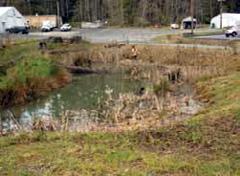
Photo: © Department of National Defence
Engineered wetland in the firefighter-training area
Background
The Department of National Defence (DND) is committed to controlling potential contaminants from entering marine water bodies and implementing green solutions to stormwater management on its properties. At the DND Colwood Refuelling Facility, located outside Victoria, British Columbia, two sites - the refuelling area and the firefighter-training area - had become contaminated with hydrocarbons and suspended solids. These contaminants had the potential to be discharged into the nearby Esquimalt Harbour, which is significant to residents, First Nations, recreational boaters and beachgoers, and is also near a bird sanctuary.
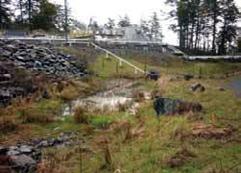
Photo: © Department of National Defence
Engineered wetland in the refuelling area
The challenge
DND had already engaged in remediation activities at both sites. At the firefighter-training area, some 3000 cubic metres of soil affected by metals and hydrocarbons were removed. DND then backfilled the site and established a 200-car parking lot and bus loop. At the refuelling area, the soil beneath a historic fuel-transfer line was remediated. DND then began to examine post-remediation options to further prevent stormwater from distributing suspended solids and hydrocarbons into marine waters.
A typical post-remediation approach involves backfilling the excavated areas to the original grade level. Drainage from these sites is usually directed to a stormwater system that might include a process to reduce sediment load. While such approaches might provide some improvement to water quality before discharge, they are often costly to install and maintain.
On behalf of DND, Public Services and Procurement Canada brought in SLR Consulting (Canada) Ltd. to design an approach aimed at reducing both the environmental impact of the sites’ activities, and the costs of remediation and maintenance.

Photo: © Department of National Defence
Drainage swale in the training area
The solution
SLR’s plan for the two locations included a series of constructed freshwater wetlands, along with surface-water control and treatment systems. Instead of directly discharging water through stormwater outlets - which would be too fast for contaminants to settle out of the water - it would first be collected from paved surfaces, then passed through surface-water control and treatment systems, such as drainage swales (low areas between ridges of land). The water would take much longer to pass through these features, allowing for more sedimentation and infiltration to the underlying soil. The runoff would then enter the constructed wetlands. The wetlands themselves would be used to treat dissolved metals and hydrocarbons before discharging the water into Esquimalt Harbour.
- In the firefighter-training area, SLR designed a swale system around the parking lot to capture all the hard surface runoff. Check dams, constructed at regular intervals along the drainage swales, slow the flow and increase water-retention time before its discharge into the wetland. Two retention ponds were constructed and vegetated with aquatic species, while transitional species were placed in the flood zone and native species in the upland area. The first pond functions as a primary settling pond, which then drains to a second pond when the water level is high enough.
- At the refuelling facility, SLR constructed a natural drainage swale with rock riffles and small pools that connected to three constructed wetlands. DND had already established a network of natural drainage swales throughout the catchment area that tied into the stormwater-management system. The wetlands are designed to allow each pond to fill up and then overflow into the next. Each pond has been vegetated with aquatic plants, transitional species and native species. The wetlands have also been designed to capture and treat any upland contaminants that may be directed into the ponds.
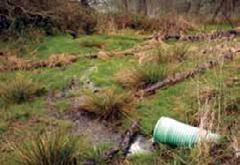
Photo: © Department of National Defence
Final discharge from the training area
Outcomes and benefits
The DND FCSAP project at the Colwood Refuelling Facility was a collaborative effort between DND, PSPC and SLR, which was successful in implementing an innovative approach to manage historical contaminants. With the wetlands and natural drainage swales in place, the volume of contaminants has been reduced, and solids discharged to marine waters has been suspended, at much lower installation, overhead and maintenance costs than traditional stormwater-management systems would incur. The wetlands now promote biodiversity by increasing the natural habitat for native vegetation and waterfowl.
This project was made possible with support from the Federal Contaminated Sites Action Plan (FCSAP), a program aimed at reducing the environmental and human health risk, and associated federal financial liabilities, from known federal contaminated sites. More information about FCSAP is available at www.federalcontaminatedsites.gc.ca.
Public Services and Procurement Canada is mandated by FCSAP to promote the use of innovative technologies, approaches and best practices in the remediation of federal contaminated sites. This is one of a series of profiles featuring innovative, sustainable and green remediation technologies, approaches, and best practices in Canada.
Wind-powered groundwater sparging at Farnworth Lake
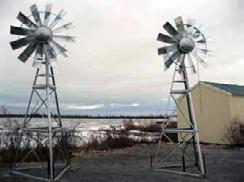
Photo: © Public Services and Procurement Canada
The active site in 2010
In an isolated, off-grid location, wind energy became the key to remediating contaminated groundwater.
Background
The Farnworth Lake Floatplane Base is located in an isolated area about 10 km southwest of Churchill, Manitoba. Over the years, the aviation storage and fuelling, along with caching of fuels, have led to subsurface contamination at the base location. As the site’s custodian, Public Services and Procurement Canada (PSPC) was responsible for its remediation.
The challenge
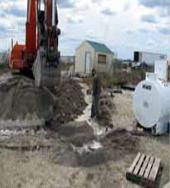
Photo: © Public Services and Procurement Canada
Covering header in trench
PSPC’s environmental assessment indicated subsurface contamination near the fuel storage facilities and at the fuelling area at the main dock. The contaminants included petroleum hydrocarbons such as benzene, toluene, ethylbenzene and xylene. The assessment also identified potential effects on a nearby lake, as the contaminant levels exceeded the Canadian guidelines for freshwater aquatic life in the groundwater that flowed toward the lake.
Any remediation plan for the site would have to contend with a number of limitations. Since the site was isolated, any equipment that could not be brought from nearby Churchill would be very expensive to transport. Because the base was off the electrical grid, any remediation equipment would also have to be powered on site. Finally, the harsh subarctic weather conditions would limit what kinds of remediation strategies could be performed, especially as sparging techniques - that is, removal of contaminants in groundwater by injecting air - depend on some permeability of the soil, and are near-impossible in freezing conditions.

Photo: © Public Services and Procurement Canada
Headers before being buried
PSPC issued a public tender for the design of a groundwater remedial system that would take these factors into account, and selected AMEC, an engineering consultant firm. After exploring alternative energy options, AMEC advanced a design that would use windmill-driven turbines to power a compressor to supply air for the sparging system. This system would remediate the petroleum hydrocarbons in the groundwater.
The solution
In AMEC’s design, four wind-powered turbines would be used to motorize the compressor to supply air to the sparging system. The windmills selected for the site were typically used to aerate fish ponds or for livestock watering sloughs; sparging would be a taller order, but AMEC determined that the windmill system could easily be adapted to supply injected air into the site’s permeable soils.
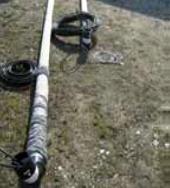
Photo: © Public Services and Procurement Canada
Risers that connect to windmills
The air itself was delivered through two lines (or “header cells”) that ran through the contaminated groundwater plumes. As with conventional sparging techniques, the windmill-driven air would increase pressure on the groundwater, driving the more volatile contaminants out.
Because the windmills would be susceptible to damage from freezing rain, sleet or snow - and the area’s occasional gale-force winds - the design provided for seasonal decommissioning and storing of the turbine units over the winter months.
Outcomes and benefits
The design was put into effect in 2010 and has since proven its effectiveness:
- Using a renewable energy source eliminates the emissions, spillage and other hazards associated with diesel generators.
- The in situ remedial approach made removal and offsite treatment of media unnecessary, further reducing costs.
- The windmills require minimal mobilization and maintenance, and the equipment is reusable.
- Compared with conventional sparging systems, the use of a renewal energy source with low operation and maintenance costs translated into savings of $100,000 to $300,000.
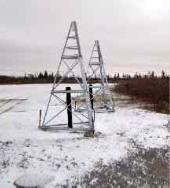
Photo: © Public Services and Procurement Canada
Seasonal shutdown in 2010
These benefits could easily be duplicated in remediation efforts at other remote and northern locations where mobilization costs are prohibitive.
This project was made possible with support from the Federal Contaminated Sites Action Plan (FCSAP), a program aimed at reducing the environmental and human health risk, and associated federal financial liabilities, from known federal contaminated sites. More information about FCSAP is available at www.federalcontaminatedsites.gc.ca.
Public Services and Procurement Canada is mandated by FCSAP to promote the use of innovative technologies, approaches and best practices in the remediation of federal contaminated sites. This is one of a series of profiles featuring innovative, sustainable and green remediation technologies, approaches, and best practices in Canada.
Fort Nelson airport remediation program
A long-term remediation program for contaminated soil provides an opportunity to identify and implement best practices for sustainable remediation.
Background
Located in northern British Columbia, the Fort Nelson Airport was constructed in 1941 for wartime use by the U.S. Army Air Force. Contamination of several sites at the airport - much of it dating back to the Second World War - affects an estimated 153 000 cubic metres of soil. To address this problem, Transport Canada has initiated the long-term Fort Nelson Airport Remediation Program, which includes assessment, remediation and soil-treatment activities involving a large number of stakeholders. The objectives for the program are to decrease greenhouse gases associated with the clean-up and to divert waste from the landfill by reducing, reusing and recycling materials.
The challenge
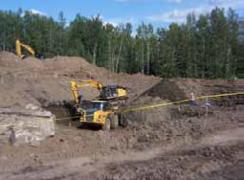
Photo: © Transport Canada
Soil treatment at Fort Nelson Airport
As part of the program, Transport Canada initiated a pilot project to identify and implement several best practices for sustainable remediation. This initiative will also lead to the identification of performance indicators that can be used to develop a project management tool to aid in the selection of green remediation approaches at other federal sites.
Several challenges common to remediation efforts in remote locations also apply to Fort Nelson Airport: there is a limited season in which remediation activities can take place, electrical power is at a premium, and equipment and materials are expensive to move. There is also limited access to recycling services and alternative fuels.
Two challenges were specific to designing the sustainability initiatives for the Fort Nelson Airport. First, the project timeline had already been defined by the overall remediation effort, which meant that project managers and analysts had to accommodate the schedule they were given. Second, though reducing emissions was a core goal of the project, the federal government cannot purchase carbon offsets.
The solution
In 2008, Transport Canada implemented a Sustainability Management Plan to measure greenhouse gases and encourage waste-diversion practices that continued throughout the project. At the Fort Nelson Airport, Transport Canada also worked with consultants to develop sustainable remediation practices specific to the site.
The procurement process used to select contractors included sustainability requirements, which were built into the contracts of companies that were selected for the work.
The consultants and contractors completed fuel records, met sustainability requirements, and provided feedback on program effectiveness and areas for improvement.
Transport Canada and its suppliers incorporated sustainable remediation and best practices throughout the remediation process. During the course of the project, several policies to promote sustainability were identified and put into practice, in areas such as:
- recycling and reuse of materials,
- prohibition on idling vehicles,
- alternative methods of transportation, such as carpooling and cycling,
- fuel-efficient heavy equipment,
- reporting of fuel consumption, and
- project-based accounting for greenhouse gas emissions.
These policies reached into almost every type of process used in the remediation effort. For example, a new tilling and raking method was implemented at the soil-treatment facility in 2010. As the table shows, project officers tracked both the fuel consumed and the amount of soil treated - and were able to demonstrate the effectiveness of the new tilling and raking method, which saved 7873 L (42%) of fuel for treating roughly the same amount of soil.
| Soil - treatment indicator | Total fuel (L) | Volume of soil treated (m3) | Performance |
|---|---|---|---|
| 2009 | 19 068 | 11 070 | 1.7 L/m3 |
| 2010 | 11 195 | 11 100 | 1.0 L/m3 |
Outcomes and benefits

Photo: © Transport Canada
Site inspection, 2008
Best practices emerged from this project in several areas.
Process efficiency
- Create a process that facilitates discussions and feedback.
- Develop sustainable remediation practices that are specific to the site.
- Use local contractors to minimize mobilization to and from the site.
Reporting requirements
- Use consistent contract wording to ensure that parties understand their requirements.
- Standardize data reporting so that it can be aggregated from many suppliers.
New methodologies
- Implement practices to reduce fuel consumption and decrease greenhouse gas emissions.
- Build the soil-treatment facility on site to decrease emissions associated with transporting soil.
Performance indicators
- Develop soil-treatment performance indicators to measure levels year to year.
Challenging the project team to consider sustainability in the remediation process resulted in a number of best practices that resulted in reducing the environmental footprint of the project.
This project was made possible with support from the Federal Contaminated Sites Action Plan (FCSAP), a program aimed at reducing the environmental and human health risk, and associated federal financial liabilities, from known federal contaminated sites. More information about FCSAP is available at www.federalcontaminatedsites.gc.ca.
Public Services and Procurement Canada is mandated by FCSAP to promote the use of innovative technologies, approaches and best practices in the remediation of federal contaminated sites. This is one of a series of profiles featuring innovative, sustainable and green remediation technologies, approaches, and best practices in Canada.
Page details
- Date modified: